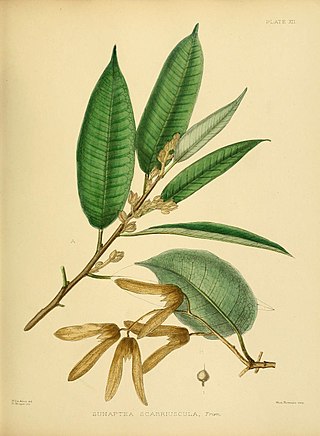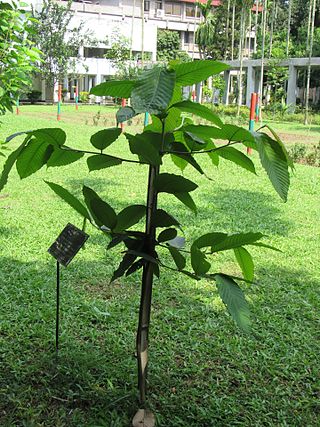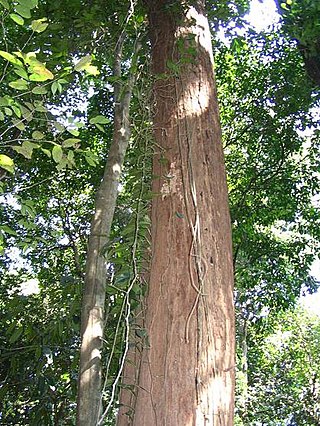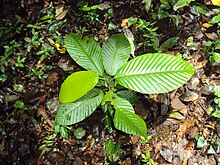
Dipterocarpaceae is a family of flowering plants with 22 genera and about 695 known species of mainly lowland tropical forest trees. Their distribution is pantropical, from northern South America to Africa, the Seychelles, India, Indochina, Indonesia, Malaysia and Philippines. The greatest diversity of Dipterocarpaceae occurs in Borneo.

Antidesma is a genus of tropical plant in the family Phyllanthaceae formally described by Linnaeus in 1753. It is native to tropical Africa, S + E + SE Asia, Australia, and various oceanic islands. The greatest diversity occurs in Southeast Asia.

Kayea is a plant genus in the family Calophyllaceae. Its species range from Bangladesh and the eastern Himalayas to Sri Lanka, Indochina, Peninsular Malaysia, Borneo, Sumatra, the Philippines, New Guinea, and Queensland.
Dipterocarpus acutangulus is a species of tree in the family Dipterocarpaceae. The species name acutangulus is derived from Latin and refers to the ribs of the fruit calyx tube. It is native to peninsular Thailand and Malaysia and also Borneo, where it is locally known as keruing merkah or keruing beludu. It is an emergent tree up to 60 m tall. The tree occurs in mixed dipterocarp forests found on sandy and sandy clay soils on coastal hills and inland ridges, up to 1000 m elevation. It occurs in at least one protected area.
Dipterocarpus kerrii is a species of tree in the family Dipterocarpaceae, native to the Andaman Islands, Sumatra, Borneo, Peninsular Malaysia, Laos, Myanmar, the Philippines, Singapore, Thailand and Vietnam.

Chionanthus, common name: fringetrees, is a genus of about 140 species of flowering plants in the family Oleaceae.

Actinodaphne is an Asian genus of flowering plants in the laurel family (Lauraceae). It contains approximately 125 species of dioecious evergreen trees and shrubs.

Dipterocarpus grandiflorus is a species of flowering plant in the Dipterocarpaceae family. It is an endangered medium hardwood tree of Southeast Asia. It is a large tree which can grow up to 50 metres tall.

Hopea is a genus of plants in the family Dipterocarpaceae. It contains some 113 species, distributed from Sri Lanka and southern India to the Andaman Islands, Myanmar, southern China, and southward throughout Malesia to New Guinea. They are mainly main and subcanopy trees of lowland rainforest, but some species can become also emergent trees, such as Hopea nutans.

Vatica is a genus of plants in the family Dipterocarpaceae. Its species range from India and southern China through Sri Lanka, Indochina, Indonesia, the Philippines, and New Guinea.

Cotylelobium is a genus of plants in the family Dipterocarpaceae. The name Cotylelobium is derived from Greek and describes the receptacle. It contains five species distributed in Sri Lanka, Peninsular Thailand, Sumatra, Peninsular Malaysia and Borneo. All five species are listed on the IUCN redlist, as either vulnerable, endangered or critically endangered.

Anisoptera is a genus of plants in the family Dipterocarpaceae. It contains ten species distributed from Chittagong in southeast of Bangladesh to New Guinea.

Dipterocarpus condorensis is a species of plant in the evergreen or semi-evergreen family Dipterocarpaceae.
Dipterocarpus crinitus is a species of plant in the family Dipterocarpaceae. The species name is derived from Latin and refers to golden-brown bristle-like hairs that cover the plant parts. It is an emergent tree, up to 60 m tall, in mixed dipterocarp forest on sandy clay soils. It is a medium hardwood sold under the trade names of keruing. It is found in Peninsular Thailand, Sumatra, Peninsular Malaysia and Borneo.

Pteroceras is a genus of flowering plants from the orchid family, Orchidaceae. It is native to China, the Indian Subcontinent, and Southeast Asia.
Dipterocarpus dyeri (Khmer: rôyiëng, chhë tiël pruhs, chhë tiël th'nô:r, local name Kompong Thom: chhieutiel chgor, name used for commercial timber and the group of trees harvested for such: keruing, Vietnamese: Dầu Song Nàng, is a species of tree in the family Dipterocarpaceae found in Myanmar, Thailand, Peninsular Malaysia, Cambodia, Vietnam, and northwestern Borneo. The tree is found in rain forest and lowland semi-evergreen dipterocarp forests, an alternative habitat description is mixed dense forests of the plains, mainly among rivers and valleys. The tree is a climax or late successional species, which in some secondary forests forms relatively young pure colonies. The conservation status is based on rates of habitat loss, the major threat to the taxa, though in Vietnam it is cited as having a less threatened conservation status of Vulnerable.

Dipterocarpus turbinatus is a species of tree in the family Dipterocarpaceae native to north-eastern India and mainland Southeast Asia, and cultivated in surrounding regions. It is an important source of the wood known as keruing, and is often used in the plywood industry.

Anthoshorea is a genus of flowering plants in the family Dipterocarpaceae. It includes 23 species of trees native to tropical Asia, ranging from India and Sri Lanka to Indochina, south-central China, and Malesia.

Richetia is a genus of flowering plants in the family Dipterocarpaceae. It includes 33 species of trees native to Peninsular Thailand, Peninsular Malaysia, Sumatra, Borneo, and the Philippines.
Rubroshorea is a genus of flowering plants in the family Dipterocarpaceae. It includes 71 species of trees native to Malesia and the Caroline Islands.

















